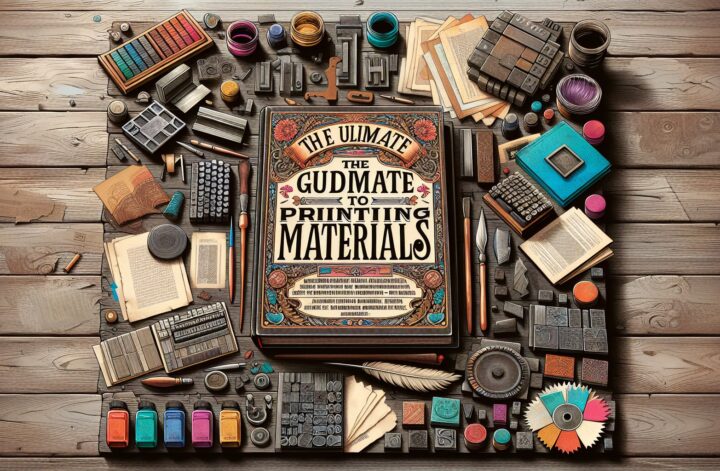Whether you’re a professional designer or a DIY enthusiast, choosing the right printing materials is crucial for the success of your project. With a wide variety of options available in the market today, it can be overwhelming to select the best materials that meet your specific requirements. In this article, we will explore some of the most common printing materials and provide insights on their characteristics, applications, and considerations. So, let’s dive in and make an informed decision!
1. Paper
Paper is the most commonly used printing material due to its affordability, versatility, and accessibility. However, not all papers are created equal, and selecting the right type for your project is essential. Here are some popular types of paper used for printing:
a. Bond Paper
Bond paper, often referred to as uncoated paper, is a traditional choice for printing documents. It is widely used for everyday printing needs such as letters, invoices, and reports. Bond paper has a smooth surface that allows for clear text printing, making it ideal for projects where readability is key.
b. Coated Paper
Coated paper is known for its glossy or matte finish, thanks to a layer of coating applied during the manufacturing process. The glossy coating provides a shiny appearance, while the matte coating offers a more subdued look. Coated paper is commonly used for brochures, flyers, photography prints, and high-quality presentations. It enhances color vibrancy and detail, making it a popular choice for projects that require visual appeal.
c. Cardstock
Cardstock is a thick, sturdy paper that offers more durability than standard printing paper. It is commonly used for printing business cards, invitations, postcards, and other items that need to withstand wear and tear. The thickness of cardstock is measured in points, with higher points indicating a thicker and more substantial paper.
d. Specialty Papers
Specialty papers cater to specific printing needs and can add uniqueness to your project. Examples of specialty papers include textured paper, metallic paper, translucent paper, and handmade paper. These papers are often used for wedding invitations, high-end packaging, artistic prints, and other projects that require a touch of elegance or creativity.
When choosing paper for your printing project, consider factors such as weight, color, finish, and intended use. Always take into account the printer’s specifications to ensure compatibility and optimal print quality.
2. Fabric
Printing on fabric opens up a whole new world of possibilities, allowing you to create custom designs on clothing, accessories, and home decor items. Here are two common methods for printing on fabric:
a. Screen Printing
Screen printing is a versatile technique that involves creating a stencil (also known as a screen) and applying ink through the screen onto the fabric. It is ideal for designs with solid colors or simple shapes. Screen printing provides vibrant, long-lasting prints on various types of fabrics, including cotton, polyester, and blends.
b. Heat Transfer Printing
Heat transfer printing, also known as iron-on printing, is a popular and accessible method for printing on fabric. It involves transferring designs from a special transfer paper onto the fabric using heat and pressure. Heat transfer printing allows for detailed, full-color designs and is commonly used for creating custom t-shirts, tote bags, and other fabric-based products.
Before choosing fabric printing materials, consider factors such as the type of fabric, desired print quality, durability, and washability. Certain fabrics may require specific inks or techniques, so take the time to research and select the most suitable materials for your project.
3. Plastics
Printing on plastic materials is widely used across various industries, including advertising, packaging, and manufacturing. Here are some popular plastic printing options:
a. Vinyl
Vinyl is a durable and versatile plastic material used for printing adhesive stickers, decals, banners, and signage. It is weather-resistant, making it suitable for indoor and outdoor applications. Vinyl printing materials come in various finishes, including glossy, matte, and transparent.
b. Acrylic
Acrylic is a transparent plastic material known for its excellent clarity and impact resistance. It is often used to create signs, displays, and point-of-purchase (POP) materials. Acrylic prints provide a professional, high-end look, making them ideal for retail environments and exhibitions.
c. Polypropylene
Polypropylene is a lightweight, flexible plastic material commonly used for printing flexible packaging, labels, and promotional materials. It offers excellent resistance to water, chemicals, and tearing. Polypropylene prints are suitable for applications that require durability and moisture resistance.
Consider factors such as the intended use, environmental conditions, and durability requirements when selecting plastic printing materials. Each plastic material has its own unique characteristics and suitability for different applications, so choose wisely.
Conclusion
Choosing the right printing materials is crucial to achieving the desired results in your projects. By understanding the characteristics, applications, and considerations of different materials such as paper, fabric, and plastics, you can make informed decisions that align with your objectives. Whether you’re printing documents, creating custom fabric designs, or producing plastic signage, take the time to research and select materials that meet your specific needs. Remember, the right materials can elevate the quality, durability, and visual appeal of your printed outputs. So, go ahead and experiment with different materials to bring your creative visions to life!


